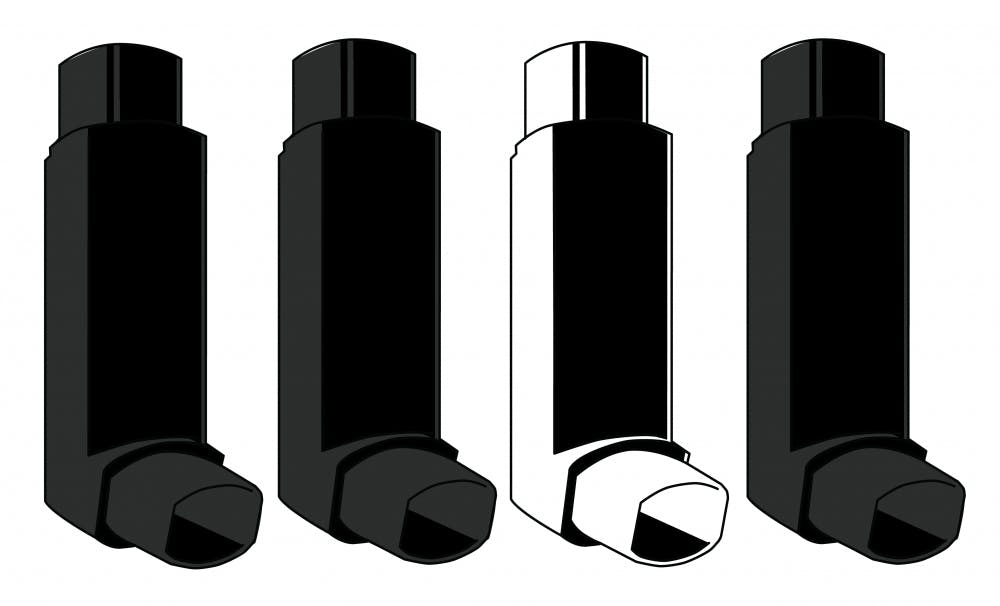Dr. Sarah Rhoads MD’16 RES’20, a University practitioner who is a resident at Hasbro Children’s Hospital, has several tricks up her sleeve for helping children who come into the hospital with asthma exacerbations.
When young patients’ exacerbations begin to subside, Rhoads asks them to blow bubbles or puff on pin wheels. This helps them practice taking deep breaths, making sure “they’re keeping their lungs open.” Sometimes she’ll give patients Popsicles. “When a Popsicle melts it can be a secret way of keeping a kid hydrated, if they’re willing to take the bait,” she said.
Mónica Huertas, a Providence resident, has three children who have asthma. She and her children have started calling the doctors at Hasbro “the Popsicle doctors.”
From the moment a child enters the emergency room with an asthma exacerbation, the medical staff at Hasbro launch into a well-rehearsed protocol. It is a situation they see often: Asthma is the most common chronic illness among Rhode Island’s children, The Herald previously reported. Asthma also disproportionately burdens urban, low-income communities of color.
For a child with chronic asthma, the illness can have multiple consequences, from Intensive Care Unit stays to school absences. In addition, asthma medication and ER visits can impose a financial burden on families.
Most children who come into the hospital with asthma exacerbations receive an albuterol dose, which helps open up their airways and is found in prescription rescue inhalers. Sometimes children also receive steroids to calm inflammation. “Most kids at that point are doing okay,” Rhoads said.
The staff’s goal is to make sure that children can go four hours or more without needing albuterol. If their condition necessitates breathing treatment every one to two hours, they get transferred into more intensive treatment areas.
In that scenario, Rhoads will communicate the message to the family by telling them that their child “has shown that he is getting a little bit better, … but we think he needs to be watched closely.”
Dr. Nicholas Nassikas MD ’15, a University Pulmonary, Critical Care and Sleep Medicine fellow specializing in asthma, treats patients who have been transferred to the ICU for asthma exacerbations. He helps the ICU’s staff navigate life support machines that can provide oxygen for those patients, or even breathe for them. “Asthma is scary because it can get very bad very quickly,” he said.
In 2016, when Rhoads was an intern at the hospital, a girl suffering from an asthma crisis was brought into the emergency room by Emergency Medical Services. She was having such a hard time breathing that she couldn’t even talk. The girl was taken into a specialized room within the ER where she received heightened treatment before being transferred to the ICU. The breathing treatments she received helped her recover and she “went home a day or two later,” Rhoads said. It was the first time in her medical career that she had witnessed a situation where a child with asthma ended up in the ICU.
In most cases, children leave the hospital relatively quickly, Rhoads said. When a child who is having a really tough time breathing receives “a few simple therapies” that make them feel better, and they end up “running out the door, … that feels great,” she said.
After an asthma exacerbation, the child leaves the hospital with a piece of paper explaining how to treat asthma if it happens again. One of the hardest parts of Rhoads’ job is seeing children come to the emergency room repeatedly because their asthma is not well controlled.
Sometimes she has to write absence notes for those children if they missed school while they were in the hospital because of asthma.
Asthma contributes to school absenteeism, according to Dr. Daphne Koinis-Mitchell, professor in the departments of Psychiatry and Human Behavior and Pediatrics and director of the Community Asthma Program at Rhode Island Hospital.
“We see the rates of absenteeism are much higher in children with asthma in urban school districts compared to children without asthma,” she said, adding that children with asthma miss, on average, two more weeks of school than children without asthma. In some districts with high asthma prevalence, this difference is larger.
There are multiple factors causing asthma-related absenteeism, just as there are multiple factors causing asthma itself.
After spending time in the hospital, children might be tired and parents may choose to keep them home. Some caregivers do this “for fear that (their children) may experience asthma symptoms when they’re in a school setting,” Koinis-Mitchell said.
Even if they go to school, lost sleep due to asthma can affect a child’s academic performance, because it can make it harder for them to pay attention and concentrate in class, she said.
In order to help families better control their children’s asthma, Hasbro has established programs on asthma management education tailored to caregivers and children. Some of these efforts have existed for over 20 years, Koinis-Mitchell added.
One of these, the Rhode Island Asthma Integrated Response (RI-AIR), is one of only four programs of its kind in the country and receives federal funding. RI-AIR identifies children with asthma living in high-risk areas, conducts screenings and designs tailored, evidence-based interventions. “If (families) adhere to the intervention, their asthma outcomes will improve,” Koinis-Mitchell said, adding that these outcomes include school absenteeism and academic performance.
The intervention might include coordinating with the school nurse and other staff at the child’s school.
Some schools have multiple systems in place to help address their students’ asthma. “Individual schools … have target teams, made up of administrators, social workers, the school nurse and other staff members, who regularly analyze attendance data and suggest interventions for students with high absenteeism,” wrote Laura Hart, Providence Public Schools District director of communications, in an email to The Herald. If the cause of a student’s high absenteeism is asthma management, the school will often reach out with additional referrals and supports.
Beyond affecting their school performance, a child’s recurring asthma can also have a high financial cost for their family.
Huertas, the Providence mother whose children frequent “the Popsicle doctor” for their asthma, has seen these costs firsthand. On her healthcare plan, the co-pay for chewable steroid tablets is $5, and inhalers cost her $35, she said. She buys four inhalers a month.
In addition, Huertas estimates that she pays $100 every time one of her children goes to the emergency room. She’s been there 11 times in the past three years, bringing the cost up to $1,100, she estimated.
This cost can impose a financial strain on some families. A few years ago, an adult family friend of Huertas’ with chronic asthma died from an exacerbation, leaving two children behind, “because she couldn’t afford her pump” medication, Huertas said. “I was like, here’s an albuterol, … take mine, but I guess it just wasn’t enough. She died from a(n) asthma attack, it’s so sad, and I always get scared, I take my kids right to the doctor.”
And at the doctor’s, the cycle of asthma’s effects on children’s everyday lives begins all over again.





